Up until last year, SEO professionals were wondering if AI-generated content could rule search results amidst concerns regarding the quality of AI writing tools. As our AI SEO Benchmark Report found, AI-generated content can definitely make it to the top of SERPs, with over 13% of the top-ranked content on Google being AI-written.
Fast forward a year, in May 2024, Google launched AI Overview, an AI-created section above organic SERPs. Now, the talk (to some extent) has shifted from AI SEO copywriting to AI-driven search results. With this new development, a novel optimization technique has emerged: generative engine optimization (GEO).
Going forward, as AI search engines become more commonplace, if you want to appear higher in search engines, you must optimize for AI-generated results. Our guide discusses some advanced GEO optimization strategies that you should master before AI results become a standard in search engine ranking worldwide.
- GEO Essentials: A Quick Refresher Before Diving Deeper
- Crafting AI-Friendly Snippets: Get Your Content Featured by AI Engines
- Mastering NLP: Tailoring Your Content for AI's Language Understanding
- Stay Fresh: Real-time Content Updates to Dominate AI Rankings
- Build Authority with AI-Optimized Link Building and Citations
- Optimizing for Multimodal Search: Harnessing Text, Images, and Videos
- Tailored GEO Strategies: Industry-Specific AI Optimization Tactics
- How to Track GEO Success
- Overcoming Challenges and Seizing Opportunities with GEO
- Master Advanced Optimization for AI-Driven SERPs
- Frequently Asked Questions
GEO Essentials: A Quick Refresher Before Diving Deeper
Before we go on to explain advanced strategies, let's briefly go over generative engine optimization (GEO). In the simplest words, GEO means optimizing your web content for AI-generated search results.
Unlike SEO, in which you optimize your content for search engines, in GEO, optimization strategies are aimed at improving your content's visibility in AI-generated results. AI search engines operate differently from traditional search engines in that they focus more on user intent and conversational keywords than backlinks, keyword optimization, technical SEO, and other traditional SEO strategies.
AI-generated results also tend to display more rich snippets, featured snippets, and answer boxes, making them more visually appealing and informative for users.
Based on this working mechanism, some strategies that work for GEO are:
- Content Relevance: Since user intent is the key focus of AI search engines, your content must be highly relevant to the user's query. Long-tail, question-based keywords are key in this regard.
- Citations: AI engines tend to show results that are cited from authoritative sources. So, citing statistics and quoting experts in your content can help improve its visibility in AI-generated results.
- Structured Data: Schema markup helps AI search engines understand your content's context better. Since these search engines show results based on contextual relevance, structured content has a higher chance of being featured in AI-generated results.
In short, AI models pick content based on its relevance, authoritativeness, conciseness, and alignment with user intent. This is somewhat in contrast to traditional search engines, where SEO strategies like backlinks, website user experience, load speed, keywords, and technical optimization also contribute to the selection of content to be displayed on the top pages.
Crafting AI-Friendly Snippets: Get Your Content Featured by AI Engines
Anyone who has used an AI-based search engine would know of the following hallmarks of AI search results:
- Short and concise
- Bulleted
Quickly go back to traditional SEO and identify which of its features resembles the features listed here. You got it: featured snippets.
So, it makes sense to use the same approach to writing content for AI search engines as you do for featured snippets in traditional SEO. Alternatively, you should create content that an AI model can summarize with ease to create a direct answer for its users.
Another important thing to keep in mind is user intent. Whatever you write, make sure it meets the user intent and doesn't stray from what the user is looking for. If you're unsure about the intent of your topic, use Semrush's Keyword Magic Tool. Search for your desired keyword, and the tool will show you the user intent for the main keyword and its variations.
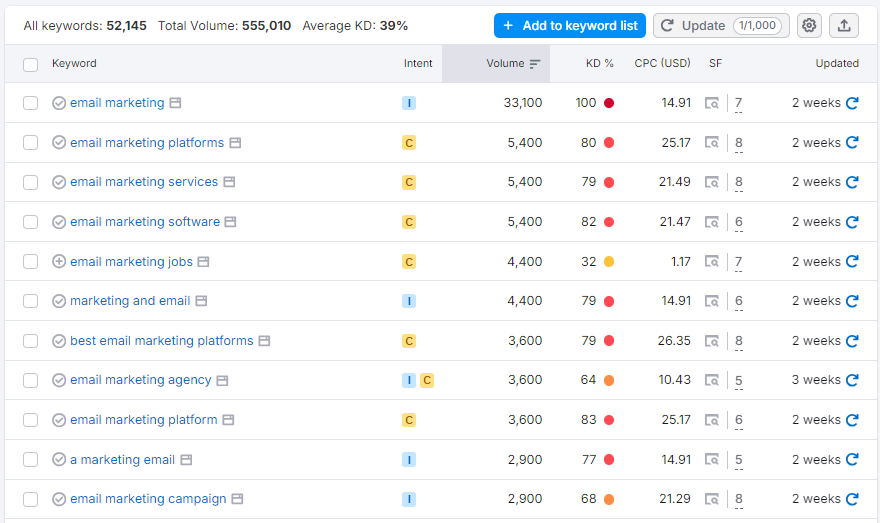
Semrush keyword magic tool
When you're creating content on the topic, keep this content in mind. For example, if it's informative, focus on providing information rather than promoting a product or service. On the other hand, if it's transactional, highlight the features or benefits of the subject you're writing about.
You can further gauge broader intent by creating topic clusters. Semrush's Keyword Strategy Builder creates a web of topic clusters based on the keywords from the Keyword Magic Tool. You can then optimize your content to address the collective intent of a topic cluster rather than simply focusing on one keyword.
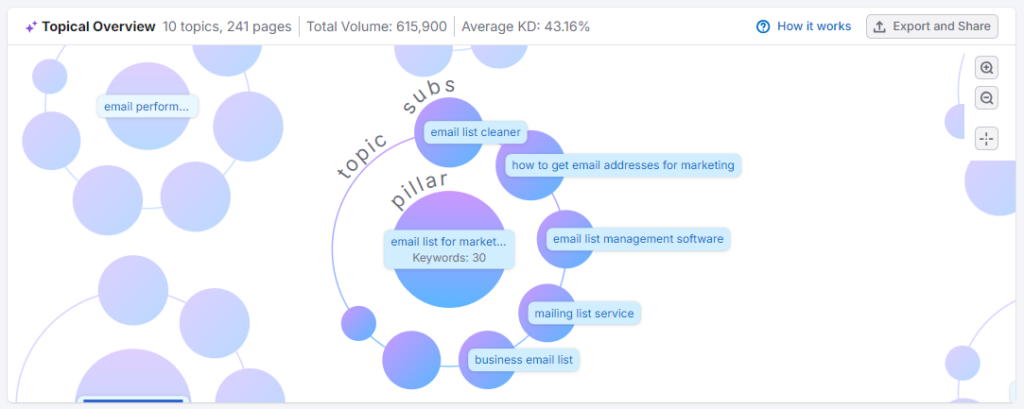
Semrush keyword strategy builder
How do AI Search Engines Select Content to Feature?
AI search engines like Perplexity.ai or Google's Gemini select content based on its relevance (with user intent) and conciseness. Ideally, your content should be informative without being overly wordy.
It also helps if your content has statistics or figures to support your claim. Since these figures increase the credibility of your content, it's more likely that the AI model will select your content as a top result.
For example, we used AndiSearch to find ''how much do influencers cost,'' and the AI search engine created a direct answer using one of our articles. In our guide on influencer rates, we have shared insights from our own report, which got picked up by AndiSearch.

Andi Search result
When we asked Perplexity.ai the same question, it showed a snippet from Shopify's article on influencer rates.
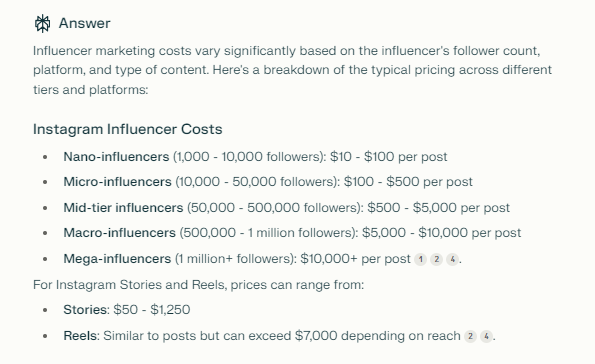
Perplexity.ai results
They have created a bullet list to summarize the average earnings for different types of influencers, making it easier for the AI model to pull the relevant information.

Shopify content structuring
These two examples indicate that both conciseness and relevance come into play when AI models select content. You can either make your content so relevant and authoritative that it gets chosen or present it in a modular and condensed way so that the AI search engine can simply extract the necessary information.
Mastering NLP: Tailoring Your Content for AI's Language Understanding
It makes a lot of sense for you to use the same language in your content that AI models use to understand text. After all, if AI is unable to comprehend your content, it's less likely to display it as a top result.
While traditional search engines speak the language of keywords, AI models like GPT understand semantic relationships between words. So, your content should not only contain relevant keywords but also use them in a way that reflects their true meaning. For example, if your article is about "influencer rates," AI would expect to see words like "cost," "earnings," "compensation," and so on, rather than just a repetition of the keyword "influencer rates."
You can use the Keyword Magic Tool to find these keyword variations or synonyms to use in your content. In addition, use the following strategies to bridge the gap between your content and AI's language understanding.
Answer Conversational Queries
How do you ask an AI model something? Typically, people don't say something like "email marketing strategies" and expect an answer. Instead, they ask a question such as "What are the best email marketing strategies for an eCommerce business?". As more and more people use voice search to obtain quick answers, it's important to structure your content in a way that reflects conversational queries.
When we search for simply "email marketing strategies," Google does not show an AI Overview.

Google search results
However, when we use the long-tail, question keyword, we get an AI Overview answer. This indicates that conversational keywords trigger AI responses.

Google AI Overview
Include long-tail keywords in your content since they are more likely to contain phrases similar to those used in conversational queries. The same applies to question-based keywords. Again, you can find them in the Questions tab of the Keyword Magic Tool.
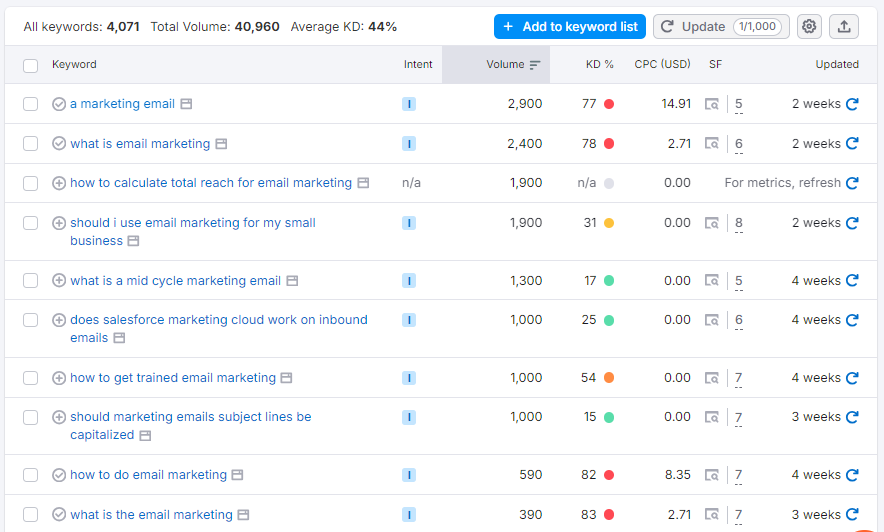
Semrush keyword magic tool questions
Use Named Entities
NLP-based search engines tend to recognize named entities, like organizations, places, people, events, and so on. You should mention these entities clearly in your content and provide context for them.
Rather than just mentioning "marketing conference," you can specify the name of the event, the date, location, and other relevant details. This will result in entity-based indexing in AI search engines.
Write Modular or Question-Based Content
Ideally, you want your content to be easy-breezy to scan through, not just for humans but also for AI search engines. There are a few different ways to do this.
One, you can divide the content under headings, creating a modular structure that makes it simple to jump straight to the part that answers a specific question.
Two, you can frame your content in an FAQ style, listing questions and providing clear answers. You can also create bulleted lists for every heading or subheading, making it easy for both humans and AI search engines to quickly navigate through your content.
For example, we input this query in Perplexity.ai: when is the 2024 Olympics? The top two sources it used were the Olympics' official website and ESPN.
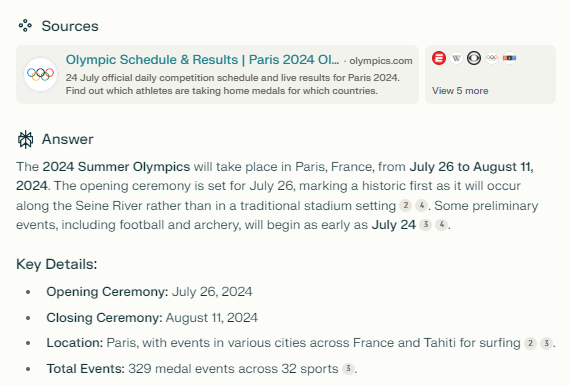
Perplexity.ai results
The Olympics' official website uses the headings with the bullet structure that we've mentioned above. They also use entities such as the location where the games are held, the date, and the duration of the tournament.
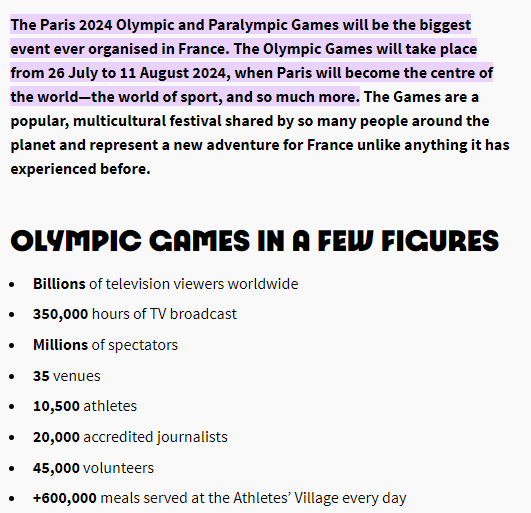
Source: olympics.com
ESPN has taken the question-based approach. They've created a list of questions as headers and answered them concisely in one or two paragraphs. Plus, they've specified entities like the stadium's name, where the games will be held, the number of cities, the date, the duration, and even the theme song's name and motto.
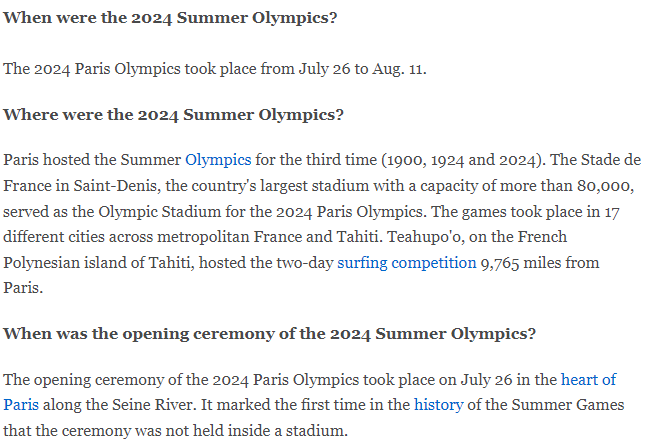
Source: espn.com
Based on this structure, ESPN's content has been selected by the AI search engine even though there are four more organic results above it in the traditional SERPs.
Stay Fresh: Real-time Content Updates to Dominate AI Rankings
AI search engines are more likely to show fresh content since it's more relevant to the users' queries. They pull from the latest information available, rewarding real-time and dynamic content with higher visibility. So, you must update your content regularly for it to remain in the top rankings, especially if you’re a small business or blog (Google recommends it!).
SPRING CLEANING GUIDE FOR YOUR SMALL BUSINESS:
🔗 Update website content
👤 Revamp Google Business Profile
📱 Refresh social media profiles
🖼️ Re-decorate workspace— Google Small Business (@GoogleSmallBiz) April 17, 2024
First off, keep your content evergreen with new insights. For example, if you've added statistics or case studies to your content, update them every time a new report or data is available. Do the same with trends. When years or trends change, update your content accordingly.
Similarly, when new segments of a topic emerge, include new subsections in your content. For example, a few years ago, articles on digital marketing strategies didn't have sections on AI marketing. However, today, you must update your old articles to include sections on AI marketing so that they can rank higher in generative search results.
You can also include dynamic content blocks in your content. For example, these could be widgets that show the latest news or tweets directly on your website. Suppose you have a finance-related website. You may display a stock market ticker or a foreign currency conversion tool on your site. Since it's updated in real-time, AI search engines are likely to pull data from it.
For example, when we searched for ''where is Bitcoin at'' in Perplexity.ai, it showed us results from Coinbase. The website shows Bitcoin fluctuations in real-time, making it a good source for AI's response.

Perplexity.ai response
You should also use time-sensitive keywords to keep your content relevant enough for AI search engines to display it in their results. For example, keywords like ''what are the best Black Friday 2024 deals'' or ''top fashion trends for Spring 2025'' will help your content rank higher during specific periods.
For example, Google's AI Overview showed us the top fashion trends for 2024 based on information from Harper Bazaar and Fashionista data.
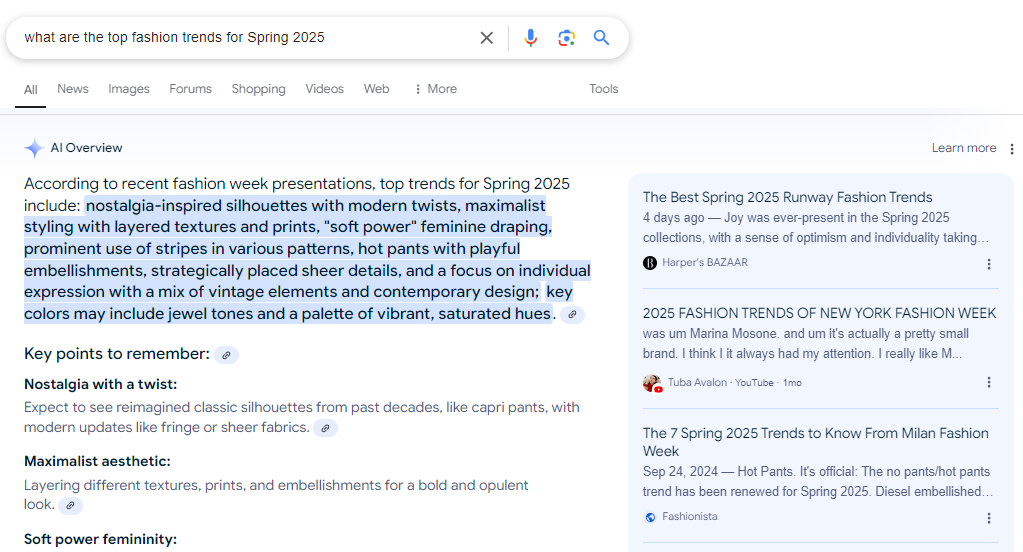
AI Overview response
Both websites have specifically used the term ''spring 2025'' in their headings and cover topics such as colors, patterns, and fabrics that are expected to trend during the season.
Build Authority with AI-Optimized Link Building and Citations
While link-building is important for traditional SEO, AI-powered search engines analyze these links a bit differently. Instead of simply counting backlinks, AI models assess link quality, relevance, and how well they fit into the overall topic landscape.
In a study by researchers at Princeton and IIT Delhi, it was found that AI search engines prioritize content that has statistics and citations. Authoritativeness also impacts content visibility in AI search engines, especially if the website has a good reputation.
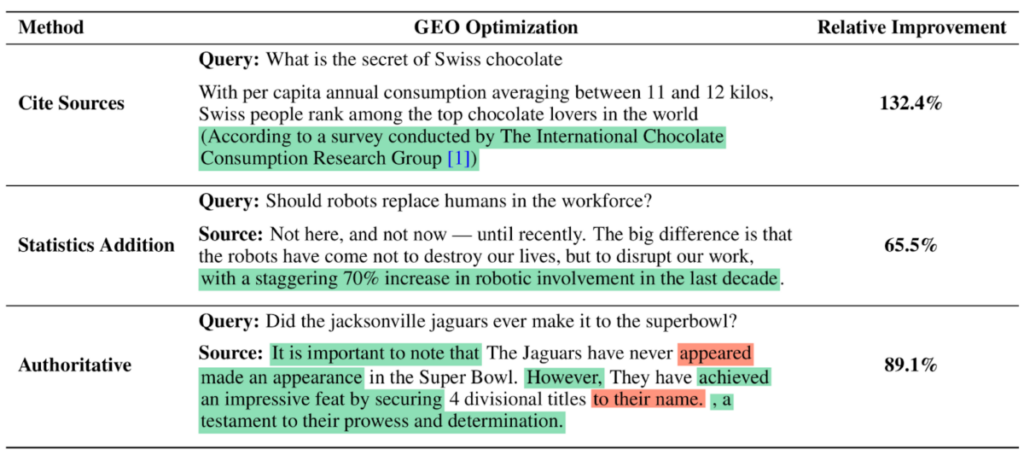
Study results
So, you should focus on two things here. First, include relevant and high-quality links in your content. This will not only improve your overall SEO but also help your content rank higher on AI search engines. Make sure you're citing authoritative sources, such as industry studies, research papers, government data, and self-conducted studies.
Second, get backlinks from reputed websites in your niche. When AI models recognize that your website is being cited by other high-authority sites, they will view your content as more authoritative and valuable, resulting in a higher likelihood of it being displayed prominently in search results.
To do this, start by analyzing your current backlink profile. The Semrush Backlink Analytics tool shows you the number of backlinks you've received along with the referring domains.
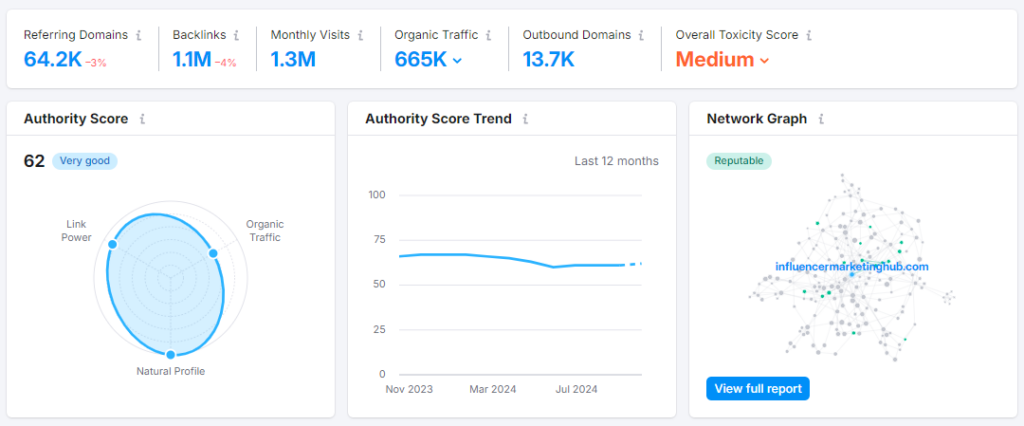
Semrush backlink analytics tool
In the Top Pages section, you'll see the pages with the most backlinks. These are the pages that have resonated well with other websites, so you can focus on creating more similar content to attract backlinks.
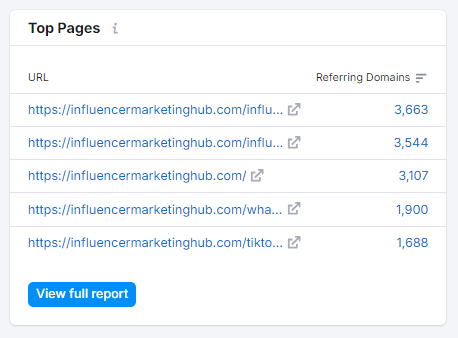
Backlink analytics top pages
You can then use the Semrush Link Building Tool to find domain prospects for your link-building efforts. The tool will show you the prospects along with the keywords you can target for backlinking. Then, you can reach out to these websites with personalized emails and ask them to include your link in their content.
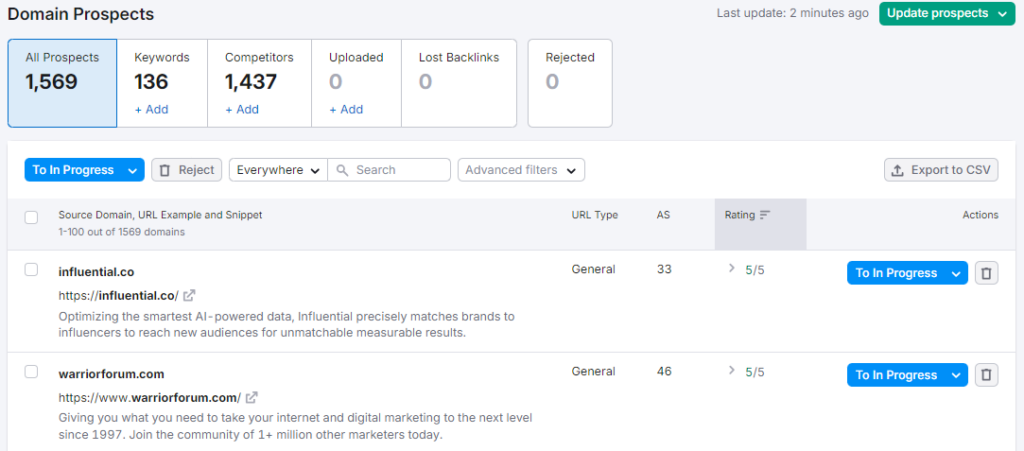
Semrush link-building tool
For example, the Backlink Analytics tool showed us that our Influencer Marketing Benchmark Report has one of the highest number of backlinks on our website. To check if this really means higher visibility in AI results, we searched for one of the statistics (how many influencers do brands work with?) on Perplexity.ai.
Lo and behold, it featured our statistics and cited our guide as the first source. This is a clear example of how backlinks from reputable websites can make your content more visible in AI search results.

Perplexity.ai results
Our example is further supported by SE Ranking's research on AI Overviews, which shows that the majority of sites shown in AI Overviews across all industries have a large number of backlinks.
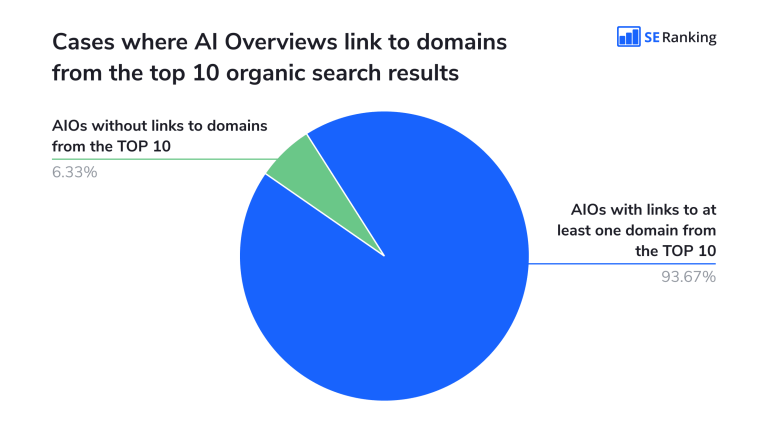
AI Overview responses from top domains
Also, AI Overviews links to at least one website in the top 10 organic search results 93.67% of the time. Since websites on Google's first page typically have a decent number of backlinks, this further reinforces the importance of having a good backlink profile for improved visibility in AI search results.
Optimizing for Multimodal Search: Harnessing Text, Images, and Videos
AI search engines don't merely show text; they also present images and videos for users to click on and explore. So, to no one's surprise, you need to create a blend of images, videos, and text in your content.
The best way to get AI models to notice these visuals is to integrate them into your content using SEO best practices. For images and videos, this means:
- Using descriptive filenames and alt tags to make them easily discoverable by AI search engines
- Compressing large files for faster loading speeds, which can also improve your content's ranking
- Optimizing image and video sizes for different devices, such as laptops, tablets, and mobile phones
- Including relevant long-tail and semantic keywords in your image captions and video descriptions
When creating images, focus on infographics or visuals that are information-rich. AI search engines tend to favor informative and educational content, so this can help boost your ranking. For example, when searching for ''how to start investing in stocks,'' we noticed that most images the search engine shows are infographics.

Perplexity.ai output
If you're writing on a topic with informational intent, charts, graphs, and infographics will be the way to go. For transactional and navigational keywords, go for images that show different features of your products or services since generative engines will likely pick them due to their affinity for intent alignment.
For example, for the query, ‘’how much do digital marketing tools cost,’’ Perplexity.ai shows pricing-related tables or illustrations. There are no infographics on tool features or selection criteria, as that’s not the intent of the searcher.
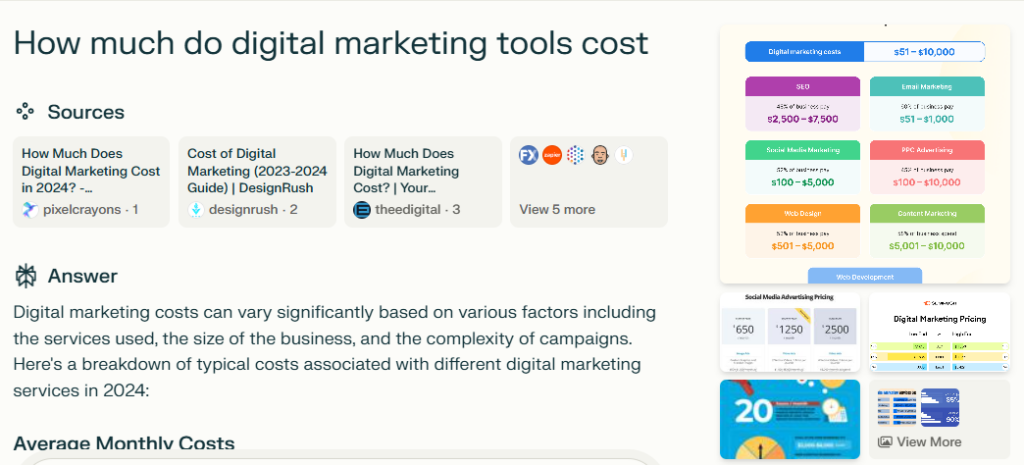
Perplexity.ai results
Tailored GEO Strategies: Industry-Specific AI Optimization Tactics
While the aforementioned tactics apply broadly to anyone optimizing their content for generative engines, some tips differ across industries. We look at them closely below.
eCommerce
In eCommerce, the user intent is typically transactional. So, that's what you need to optimize your content for.
Start with writing detailed product descriptions with long-tail keywords that AI can parse and select. Bulleted lists are great as AI can quickly scan the information and understand what your product has to offer.
Also, include high-quality images with descriptive file names that match the product and keyword. This will help AI better understand the visual aspect of your product and show images alongside textual results. If you create a product comparison table or a "Customers also bought" section, use schema markup to help AI contextualize this information.
Make sure you present your products' key features in a way that AI can easily summarize. In our search for the best smart home devices, Perplexity.ai showed us products that had well-written descriptions with clear feature explanations.
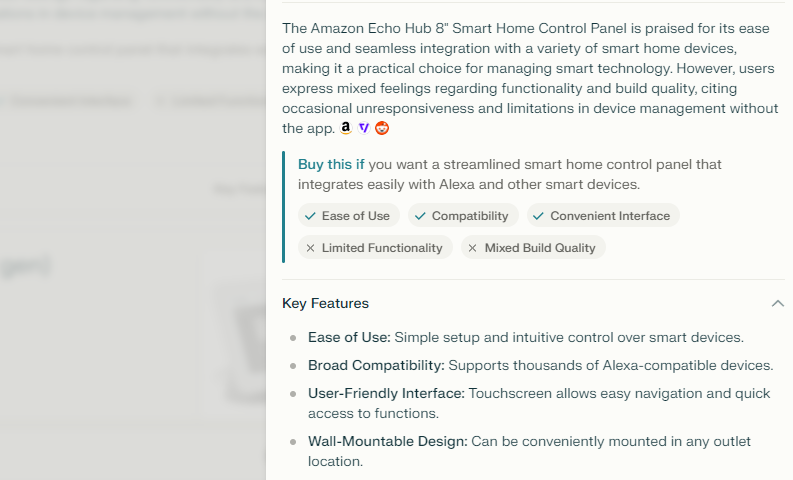
Perplexity.ai results
You can also add an FAQ section to your product pages. Since these questions are typically asked by customers, AI will pull this information from your site and show it in the featured snippets. We ran multiple Perplexity.ai searchers for products and found an Amazon product to be the top option in almost all cases. We suspect this may be due to the customer review and FAQ sections they have on their product pages, which provide AI search engines with more context and information about the product.
Healthcare
The healthcare industry, due to its high regulation, requires utmost accuracy in content writing. Since AI search engines are programmed to prioritize authoritative and accurate information, you must conduct thorough research when writing content for AI search results.
Add links to research papers, studies, and trusted medical sources to increase your content's authoritativeness. Moreover, question-based keywords are quite common in healthcare searches. So, include question-based headings and subheadings in your content to increase its chances of being featured in AI search results.
Keep updating your healthcare content for AI. If there are new studies that refute your previous content, make sure to update it.
As we explained earlier, entities are integral for the content you want AI search engines to read. In healthcare, this means using proper names for things, whether they are medications or procedures. For example, we asked Microsoft Copilot which medications can be taken for migraines, and it showed us results from sources that use proper entities, i.e., both brand and generic names for medications.
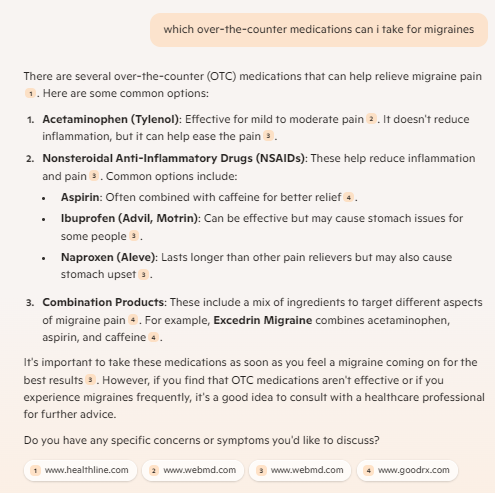
Microsoft CoPilot results
Legal
Just like healthcare, the legal industry is highly regulated. That means your content should comply with the industry's standards and regulations. Conduct thorough research, cite reputable sources, and use proper legal terminology to increase your content's credibility for AI search engines.
Keep in mind that legal searches often involve specific case scenarios or questions. So, when you're writing legal content for AI search engines, try to anticipate the questions or scenarios that your target audience might have and include them in your content.
Again, keeping in line with the need for entities, include relevant laws (with names) and legal terms in your content. These entities provide the context AI models need to show your content in response to a certain user intent. For example, when we searched for the query ''Which taxes does a corporation pay in the US,'' Perplexity.ai showed those domains as sources that use the federal names of the types of taxes.
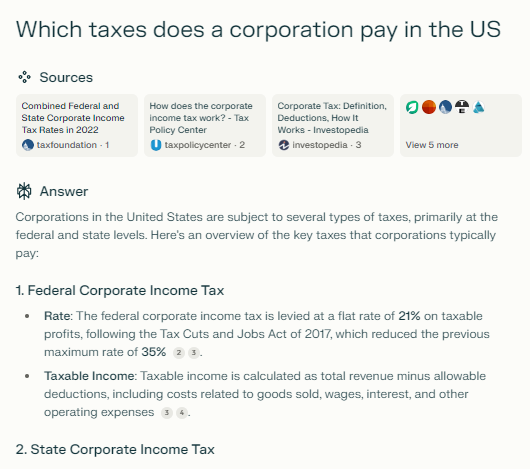
Perplexity.ai results
FAQs are also helpful in legal content, as they can provide quick answers to common questions. These FAQs should be formatted in a question-and-answer format so that AI search engines can display them as featured snippets.
Finance
The finance industry also requires a high degree of accuracy and compliance. When offering financial advice, keep your tone authoritative by including quotes from industry professionals, sharing case studies, including data and statistics, and citing reputable sources.
As with healthcare and legal content, it is important to use specific financial terms and entities in your writing. For example, instead of simply telling people to invest in stocks, specify the type of stocks or investment options available, such as individual stocks, mutual funds, or index funds.
AI search engines also have a higher affinity for numerical data, so including financial figures and statistics can help improve your content's visibility on these platforms. Plus, integrate plugins and widgets, such as calculators and charts, to provide interactive and dynamic content for your audience.
For example, the search results for the query ''how to calculate income after taxes'' on Perplexity.ai include two results with free paycheck calculators.

Perplexity.ai result
Similarly, the top result in Google AI Overviews also includes a paycheck calculator. In addition, three more results in the AI Overviews include a paycheck calculator to find your take-home pay.
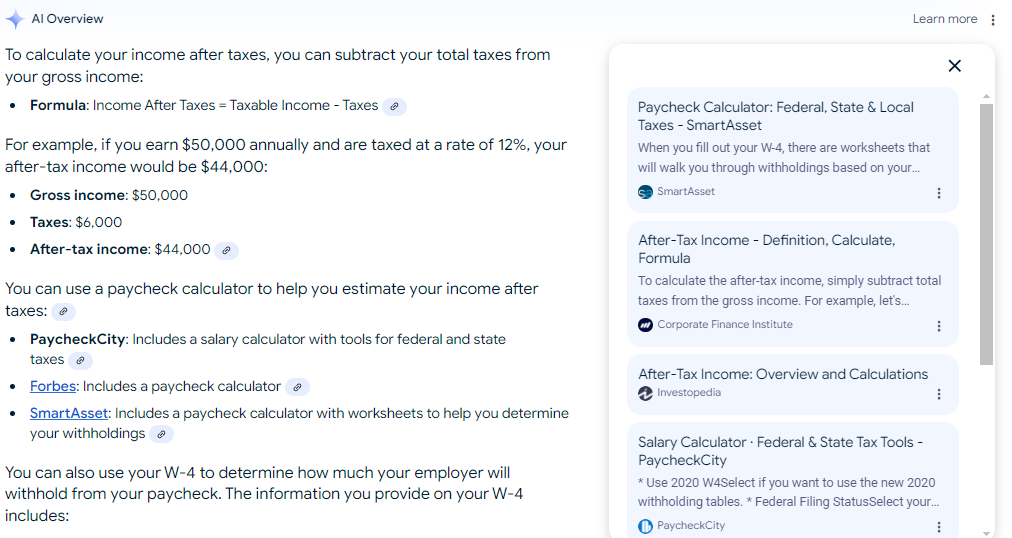
AI Overview
As with the Bitcoin example above, this real-time data increases the chances of your content's visibility. Meanwhile, calculators and tables can be presented as structured data, which can be easily indexed by AI search engines.
Education
The following tips will help optimize education-related content for AI search engines:
- Tailor your content to user intent, such as course reviews, student experiences, enrollment information, financial aid options, student success rates, career paths, etc.
- Include relevant keywords and terms specific to education, such as majors, degrees, certifications, online learning, traditional classroom settings, and so on.
- Incorporate rich media content, such as videos, podcasts, and infographics, to create modular content with higher visibility in generative engines.
- Include conversational keywords related to education and update your content, especially during admissions and enrollment season.
- Created structured FAQ sections to answer common questions and provide quick access to information.
Like finance, the educational industry can also benefit from including widgets in content. For example, if your site covers admission requirements for Ivy League schools, including a widget that allows users to compare admission requirements across all Ivy League schools can increase the chances of your content being featured in AI search results.
When we searched for the requirements to get into Harvard med school, we noticed that most results had some sort of widget, visual, table, or modular data in their content. For example, AI Overviews in Google referenced Harvard Medical School's official website, which presents information in a bulleted format with links that further expand to provide additional information.
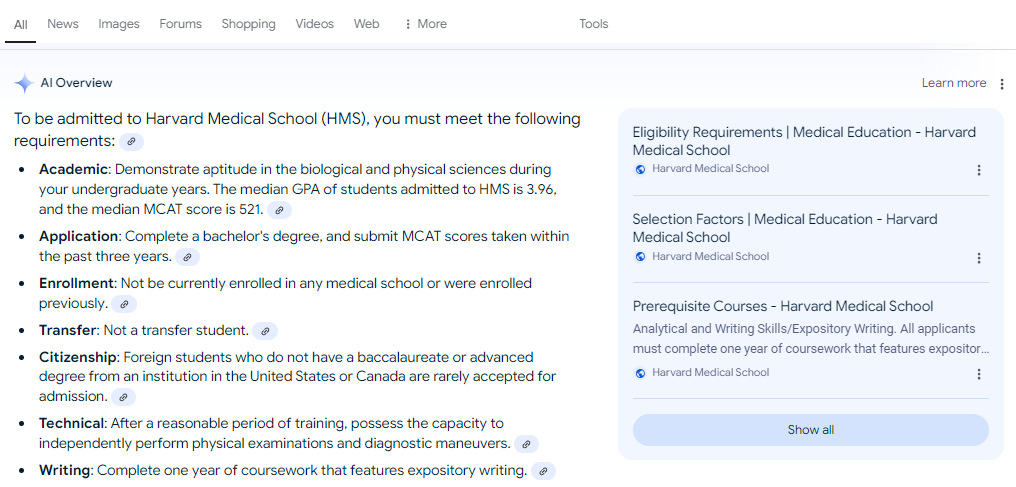
AI Overview
Perplexity.ai also referenced the university's official website but took Bemo Academic Consulting as its primary source.
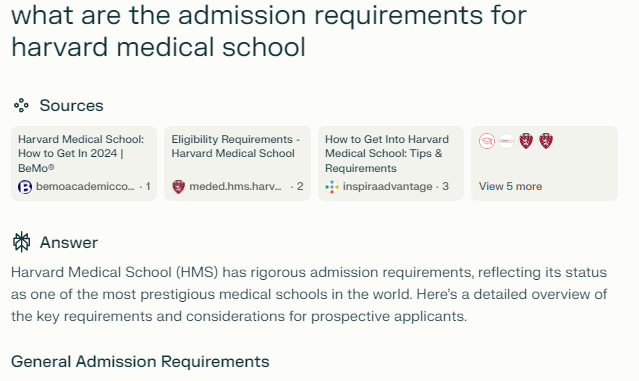
Perplexity.ai results
The website has used multiple widgets, such as career path identification, admission timeline, and course selection, which made it more appealing to AI algorithms and improved its chances of being featured in search results.
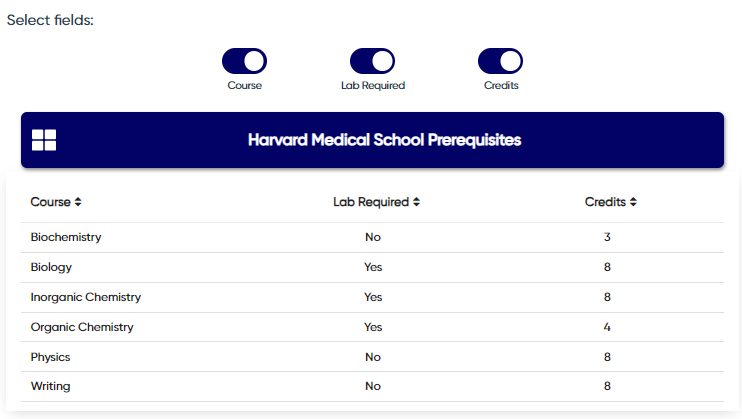
Source: bemoacademicconsulting.com
Travel
Like the finance industry, businesses in the travel sector also benefit from including calculators, planners, infographics, and maps in their content. For example, a travel blog about budget-friendly destinations could include a trip cost calculator or a budget planner to help readers plan and track their expenses.
Similarly, include images and videos in your content to appear high in searches for queries related to the ''best places to visit in XYZ...'' Populate these images with detailed descriptions that include relevant keywords and locations to improve their visibility on AI search engines.
Upon searching for the best places to visit in Cape Town, South Africa, Microsoft CoPilot showed us results from web pages that had the aforementioned attributes. For each place, they included a high-quality image with an informative description.

Microsoft CoPilot results
Again, widgets are a hot commodity in the travel industry, with AI search engines typically showing results from domains that let users find hotel prices, flight schedules, even vacation packages, airline deals, etc. Since these things keep changing, you should update this data or have dynamic widgets that refresh themselves.
For example, when we searched for how much it costs to go to France, the top source Phind showed us was a website with multiple widgets that allow you to customize costs based on the number of people, traveler type, number of meals, hotels, and other factors.

Phind result
Interestingly, this website's content is so well-structured and has so many helpful resources that it was also referenced by Microsoft CoPilot and Perplexity.ai. This shows that if you get the content elements right, you can appear high in pretty much every AI search engine.

Perplexity.ai result
How to Track GEO Success
When it comes to tracking the success of your GEO strategies, the metrics are quite similar to that of SEO. You want to measure keyword ranking (in generative engines), site visits, conversion rate, and overall revenue.
Since GEO is still new, the tools to measure its performance aren't as feature-rich as those for SEO. However, Semrush has some features you can use to track GEO success.
To get a bird's eye view of what your site's ranking is like in AI Overviews, go to the Overview tab in Domain Overview. Here, you can see the percentage of keywords your domain ranks for the AI Overviews. Check this percentage before and after implementing GEO strategies to see if there's a difference.
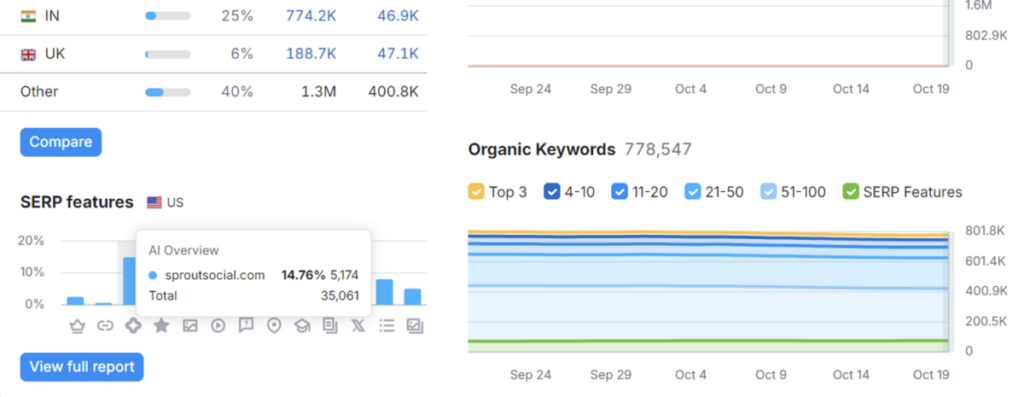
SERP features in Semrush
Use the Position Tracking tool in Semrush to see which keywords your site ranks for. If you go to the SERP features and select AI Overviews, you will see the keywords for which your website shows up in Google's AI Overviews. You can then take notes from the content in which you've used these keywords to further optimize future content for GEO.

Source: semrush.com
Meanwhile, the Organic Research tool shows you which keywords trigger AI Overviews in general. This could be for your domain or for a competitor's. Here, you can see the traffic keywords shown in AI Overviews get and the keyword difficulty (how difficult it is to rank for them).
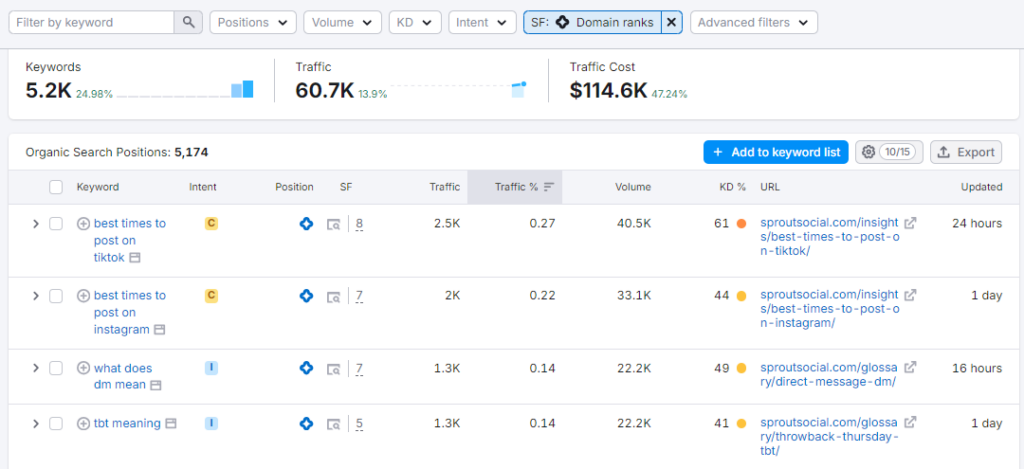
Organic research AI Overviews
You will see the traffic these keywords genera
Once you make changes to your website's GEO, you can use these tools to monitor how your site's performance has improved in AI search results on its own and in comparison to your competitors.
Overcoming Challenges and Seizing Opportunities with GEO
As a novel concept, GEO comes with several challenges. The topmost challenge is that even though it's still new and those who start now can make a place for themselves in AI search results, these search results will get saturated in the future as more businesses start optimizing for generative engines. Then, the competition for GEO may be just as hard as SEO.
However, this also presents an opportunity for early adopters to establish themselves as leaders in the GEO field and gain an edge over their competitors.
Another concern is that as AI search results take up the top spot in SERPs, impressions and CTR will decrease for organic content since they will be pushed down. Marketers can navigate this challenge by not ignoring SEO in the wake of GEO.
This is what’s happening to SEO traffic after Google rolled out AI Overviews.
We checked out search data from our SMB clients in e-commerce and local services in the US.
Here’s what we found from the AI Overview launch:
Key Metrics:
Impressions: Went down.
Clicks & CTR: Went… pic.twitter.com/ge5iczaSjQ— Neil Patel (@neilpatel) June 5, 2024
Instead, use both strategies in conjunction to fully optimize your website's presence online. It also helps to provide users with something that AI search results don't, such as a free tool, a calculator, a free template, or detailed reports. This will help increase click-through rates.
SEO agencies and marketers are also faced with the complexity of explaining this new concept to clients, who may be skeptical at first. You can win them over by explaining why it's important and what they stand to gain from implementing GEO strategies.
Master Advanced Optimization for AI-Driven SERPs
From AI SEO to now GEO, the search engine landscape has gone through massive shifts in the past few years. At this rate, marketers who do not keep up may lose rankings in both SEO and GEO.
Since there's no way to avoid this shift, the best way forward is to adapt to it. Use AI search engines in your everyday search tasks to get a sense of how they retrieve results. Then, use this knowledge to optimize your content accordingly.
We've also shared some tips above that we and other industry experts have noticed in research so far. As AI algorithms advance, the way they find and present information might change. However, till then, focus on intent-driven, structured, fresh, and entity-rich content. And once algorithms evolve, update your existing knowledge with insights from newer research and industry developments.
Frequently Asked Questions
What is Generative Engine Optimization (GEO)?
Generative Engine Optimization (GEO) means optimizing content and digital assets to ensure they appear effectively within AI-driven generative engines, such as Microsoft CoPilot, Perplexity.ai, Phind, and You.com. Some strategies used in GEO are creating natural, question-focused content, using structured data, focusing on user intent, and building strong backlinks.
How does GEO differ from traditional SEO?
GEO caters to AI search engines, which means it focuses on user intent and shows results based on user queries rather than just keywords. Traditional SEO includes a lot of strategies, from keywords to backlinking, that determine if a website will rank higher in SERPs. That means if your content satisfies the user intent, it can rank in generative engine results even if it doesn't rank in regular search engines due to poor SEO.
What are the most important GEO strategies?
Some of the most important GEO strategies are:
- Creating conversational content in a natural, question-and-answer style to align with how users interact with generative engines
- Focus on meeting the specific needs behind queries (informational, transactional, or navigational)
- Creating structured content using header tags and schema markup
- Building strong backlinks from reputable sources
- Updating your content regularly
- Building authoritative content by adding statistics, research studies, and expert quotes
Why is structured content crucial for GEO?
AI search engines rely on structured data to understand and interpret content. Their focus on content contextualization requires that you structure your content in a format that is easy for them to parse and extract information from. This includes using header tags, bullet points, lists, and schema markup to provide additional context about your content.
How can businesses optimize content for AI-driven engines like SearchGPT or Google's AI Overview?
Businesses can use the following strategies to optimize their content for AI-driven engines:
- Write like you're answering a question, keeping things conversational and straightforward.
- Make sure your content addresses specific needs—whether it's a quick fact, product recommendation, or detailed guide.
- Include questions your audience is likely to ask in a structured FAQ section.
- Update your content with new information and relevant keywords to keep it fresh.
- Include authoritative sources, statistics, figures, graphs, and quotes.
How does user intent play a role in GEO?
User intent is key in GEO because AI-powered engines prioritize delivering responses that match what users actually want. If someone's looking for a quick how-to, the AI will generate concise, actionable advice. But if they want in-depth knowledge, the generative engine will dive deeper. If you write your content according to the user's intent, it will likely be selected by generative engines.
What are the challenges of adopting GEO strategies?
Adopting GEO strategies comes with a few challenges, mainly because the technology behind AI search engines is still evolving. One issue is predictability. Traditional SEO rules don't fully apply, so it's tricky to know exactly how content will rank or be generated. Another challenge is balancing between concise and in-depth content, as AI models may summarize long posts, making detailed optimization efforts feel wasted. Plus, there's the need to constantly update strategies since generative models change rapidly.
How can long-tail keywords benefit GEO optimization?
When you focus on these keywords, you're more likely to match the nuanced questions people are asking generative engines through voice search, leading to higher relevance in AI-generated results. Plus, because long-tail keywords often indicate readiness to convert, like someone searching for "best eco-friendly car detailing service," they can drive more qualified traffic.
Will GEO replace traditional SEO?
It's unlikely that GEO will completely replace traditional SEO; rather, they'll probably coexist and complement each other. As generative engines become more prevalent, they'll change how we approach content creation and optimization, pushing us to think more about the context and intent behind searches. However, foundational SEO principles like quality content and good user experience will always be relevant.
What is the future outlook for GEO in search engine optimization?
With advancing AI tech, we can expect generative engines to become even better at understanding user intent and providing tailored responses. As a result, businesses will have to create an SEO-GEO hybrid for search engine visibility. Competitiveness on SERPs will also increase as more businesses adopt GEO strategies. This may open up new, innovative content creation techniques for businesses to stand out. Similarly, traditional keyword research and optimization may evolve to incorporate more long-tail keywords and conversational phrases.


